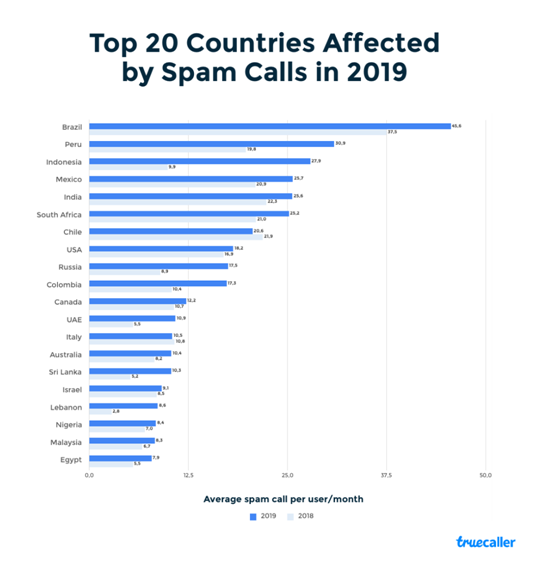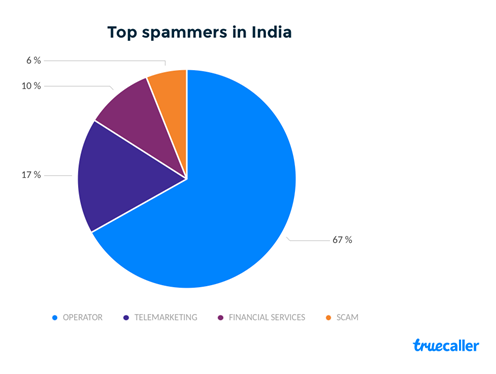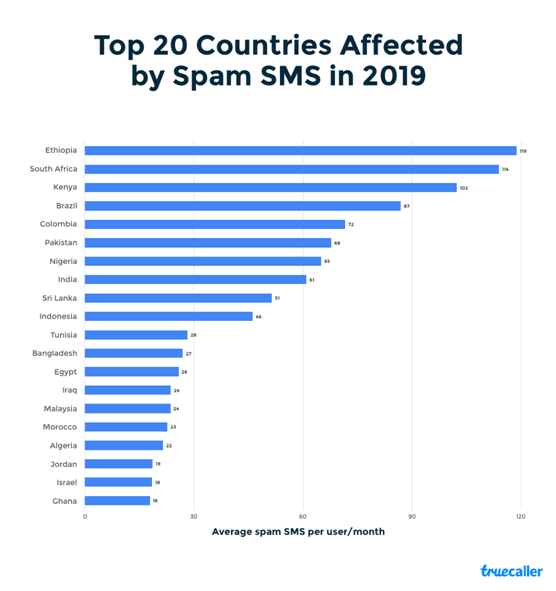Truecaller released the findings from their annual Truecaller Insights Report, that listed the Top 20 Countries Affected by Spam Calls in 2019.

This is the third edition of the report wherein there has been a significant shift in the ranking of countries that received the most spam calls.

A closer look at spam calls in India
According to the report, India has dropped down to the fifth position in terms of number of spam calls received by users globally, while Brazil continues to stay on top. However, spam calls received by users in India has continued to increase to 25.6 calls per user/month, which is a 15% upsurge from the previous year. One of the most interesting revelations that came from this year’s report was that 10% of spam calls came from financial service providers, a category that was not listed last year.

With regard to spam call categorization, operators continue to be the top spammers in India with 67% user calls received for upselling of various offers and reminders. However, with the rise of mobile payment systems and a growing middle economic class in the country, the study has witnessed banks & fintech-based organizations and telemarketing services emerging as big spammers recording 10% and 17% respectively.
Additionally, Truecaller also looked at the trends of spam SMS around the world and the report has indexed the top 20 countries that receive the most spam SMS. The data shows that spam messages are primarily received in emerging regions. India ranked at 8th position wherein users received an average of 61 spam SMS every month. The top three markets that are affected by this form of spam were in the African continent.

What other trends are we seeing?
- Digging deeper into the bigger markets, Truecaller found common categories that tie all these spam calls together. The most prominent pattern seen was that operators across the world are the biggest spammers. Another pattern noted was that scam calls are on the rise globally, and spam calls from financial services are increasing.
- Spam calls in Latin America have been increasing dramatically over the years. This year, the trend is even clearer. The countries that are seeing the biggest increase of spam calls are in Latin America. 5 out of the top 10 most affected markets are in that region.
- Peru has seen a significant increase of spam calls. Users are now getting on average 30.9 spam calls a month, making Peru the 2nd most spammed country in the world.
- The biggest increase of total spam calls comes from Indonesia. Last year Indonesia was ranked 16th, and this year the market jumped up to 3rd place, which makes it the biggest jump we have seen.
- The country that has witnessed the biggest increase of spam calls in percentage is Lebanon. Users in the market have seen an increase of spam calls going from 2.8 average spam calls/user to 8.6 – that is a 208% increase in a year.
- Although India has dropped to the 5th place (India used to be the top spammed country in the world), spam calls have been increasing by 15% over the year. Another devastating fact we found during this year is that 1 out of 3 women in India receive sexual harassment or inappropriate calls and SMS on a regular basis.
- The U.S. continues to be in the top 10 list of the most spammed countries in the world. The market saw a 7% increase of spam calls compared to last year, where it actually was decreasing. Earlier this year, we conducted a study in the U.S. and found that phone scams caused Americans to lose 5 billion dollars in 2018, and nearly 1 in every 6 American adults falls victim to scam calls.
- New markets to enter our list: UAE, Australia, Sri Lanka, Malaysia, Lebanon, Nigeria and Egypt.
- Telcos/operators are still the biggest spammers in the world, and scam calls are on the rise globally.
- Who are the top 5 markets to receive the most scam calls in the world? Malaysia (63%), Australia (60%), Lebanon (49%), Canada (48%), South Africa (39%).
The full report can be found at https://truecaller.blog/2019/12/03/truecaller-insights:-top-20-countries-affected-by-spam-calls-&-sms-in-2019/
Previous reports from 2018 can be found here while the 2017 report can be found here.

